Nature Diary
Rocks
History
Gallery
Links
Home Page
 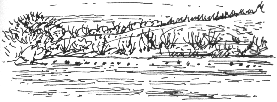
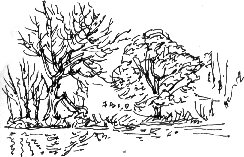 IT'S PLEASANT TO sit with a cup of coffee and sketch the late autumn landscape - the partially iced over lake, the bare trees on the ridge - from the comfort of the cafe built onto the back of Walton Hall, which stands on an island accessible only via an old iron footbridge.
IT'S PLEASANT TO sit with a cup of coffee and sketch the late autumn landscape - the partially iced over lake, the bare trees on the ridge - from the comfort of the cafe built onto the back of Walton Hall, which stands on an island accessible only via an old iron footbridge.
Walton Park, near Wakefield, was the site of what I think of as the world's first nature reserve, set up by naturalist and traveller Charles Waterton in the 1830s.
'Waterton never fired a shot within his park, never permitted dogs or keepers to range the woods, nor allowed a boat on the lake from Michaelmas to May-Day,' his friend Norman Moore tell us, with the result that 'I once, in the month of January, counted 1640 mallards, wild duck, widgeon, teals, and pochards, thirty coots, and twenty-eight Canada geese, and there must have been many more out of sight of the window.'
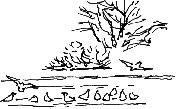 Black-headed Gulls stand on a sheet of ice near the smaller island, but most of the lake is open water. There's a group of Coots, on the lake but the Canada Geese (about 28 of them, as it happens) are standing on the shore alongside the golf course. I see a Pochard and a pair of Wigeon. A Tufted Duck flies overhead. I think there are more over by the little island, but I didn't think to bring binoculars.
Black-headed Gulls stand on a sheet of ice near the smaller island, but most of the lake is open water. There's a group of Coots, on the lake but the Canada Geese (about 28 of them, as it happens) are standing on the shore alongside the golf course. I see a Pochard and a pair of Wigeon. A Tufted Duck flies overhead. I think there are more over by the little island, but I didn't think to bring binoculars.
  To take a closer look, I walk out on the wooden staging that runs the length of the island behind the indoor swimming pool. A pair of Dabchick surface together yards from me and, as if in surprise, dive back under within a second.
To take a closer look, I walk out on the wooden staging that runs the length of the island behind the indoor swimming pool. A pair of Dabchick surface together yards from me and, as if in surprise, dive back under within a second.
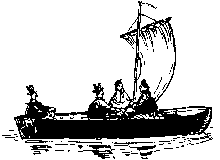 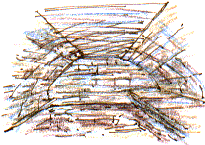 I notice the two arched entrances to the old boathouses. I can't resist peering in, over the wooden screening. In the late 1960s until the late 1970s the Hall stood derelict. It is good to see it restored and successful in its present role as the Waterton Park Hotel. Some of the original features were lost in the restoration, others were saved, but looking into this vault really is like catching a glimpse of Waterton's day. The waters of the lake still reach inside, the stone walkway still runs alongside.
I notice the two arched entrances to the old boathouses. I can't resist peering in, over the wooden screening. In the late 1960s until the late 1970s the Hall stood derelict. It is good to see it restored and successful in its present role as the Waterton Park Hotel. Some of the original features were lost in the restoration, others were saved, but looking into this vault really is like catching a glimpse of Waterton's day. The waters of the lake still reach inside, the stone walkway still runs alongside.
So this is where the boats were left from Michaelmas to May-Day.
I heard about a site with Waterton connections from Bruce Haig in Alberta this week;
Following Historic Trails
this Alberta heritage site includes material on Waterton and Blakiston (who named Waterton Lakes) . . . including a Japanese connection.

Richard Bell,
wildlife illustrator
E-mail; 'richard@daelnet.co.uk'
Next day
Previous day
Nature Diary
Wild West Yorkshire home page
|


 IT'S PLEASANT TO sit with a cup of coffee and sketch the late autumn landscape - the partially iced over lake, the bare trees on the ridge - from the comfort of the cafe built onto the back of Walton Hall, which stands on an island accessible only via an old iron footbridge.
IT'S PLEASANT TO sit with a cup of coffee and sketch the late autumn landscape - the partially iced over lake, the bare trees on the ridge - from the comfort of the cafe built onto the back of Walton Hall, which stands on an island accessible only via an old iron footbridge.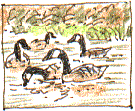
 Black-headed Gulls stand on a sheet of ice near the smaller island, but most of the lake is open water. There's a group of Coots, on the lake but the Canada Geese (about 28 of them, as it happens) are standing on the shore alongside the golf course. I see a Pochard and a pair of Wigeon. A Tufted Duck flies overhead. I think there are more over by the little island, but I didn't think to bring binoculars.
Black-headed Gulls stand on a sheet of ice near the smaller island, but most of the lake is open water. There's a group of Coots, on the lake but the Canada Geese (about 28 of them, as it happens) are standing on the shore alongside the golf course. I see a Pochard and a pair of Wigeon. A Tufted Duck flies overhead. I think there are more over by the little island, but I didn't think to bring binoculars.
 To take a closer look, I walk out on the wooden staging that runs the length of the island behind the indoor swimming pool. A pair of Dabchick surface together yards from me and, as if in surprise, dive back under within a second.
To take a closer look, I walk out on the wooden staging that runs the length of the island behind the indoor swimming pool. A pair of Dabchick surface together yards from me and, as if in surprise, dive back under within a second.
 I notice the two arched entrances to the old boathouses. I can't resist peering in, over the wooden screening. In the late 1960s until the late 1970s the Hall stood derelict. It is good to see it restored and successful in its present role as the Waterton Park Hotel. Some of the original features were lost in the restoration, others were saved, but looking into this vault really is like catching a glimpse of Waterton's day. The waters of the lake still reach inside, the stone walkway still runs alongside.
I notice the two arched entrances to the old boathouses. I can't resist peering in, over the wooden screening. In the late 1960s until the late 1970s the Hall stood derelict. It is good to see it restored and successful in its present role as the Waterton Park Hotel. Some of the original features were lost in the restoration, others were saved, but looking into this vault really is like catching a glimpse of Waterton's day. The waters of the lake still reach inside, the stone walkway still runs alongside.